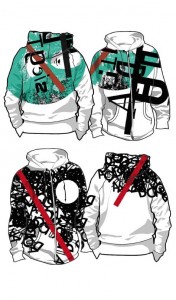The potential for collaboration between the worlds of fashion and technology have been ever-present since the initial explorations of Hussein Chalayan ten years ago. A synergy between the two fields will create a future Marshall McLuhan had long ago promised in Understanding Media. He writes “… the electric age ushers us into a world in which we live and breathe and listen with the entire epidermis”. Are our clothing and accessories the epidermal interfaces with which we can experience the world at present?
It is more than obvious that the expressive value of fashionable wearables can be greatly heightened by the integration of technology. By incorporating electronics into a garment we can transform traditional fashion elements such as colour, texture, and cut to include movement, touch, light, sound and interactivity for added tools of communication. Our input and output of information with each other can become increasingly multifaceted. Yet, it is important to recognize the significance of the word fashion in this discussion, noting that aesthetics and style have long been a rich tool for how we communicate our values, culture, status and mood individually over time. If we are creating intelligent technological designs for our clothing, it is important that we create intelligent fashion designs as well – allowing for expressions in personal style.
Two inspirational projects recently developed in my class, Fashionable Technologies Projects at the department of Interface Cultures at the University of Arts in Linz, are great examples of what I call aesthetic interaction interfaces. Meaning, both projects engage the wearer and the audience immediately through well-designed interactive interfaces and aesthetically pleasing designs. Their styles – one inspired by Dadaist art and the other by bird behavior – work well in the context of their conceptual purposes and exhibit how style and technology can come together to create a new type of fashion experience.
DADAgear[1] , developed by Mauro Arrighi, Anika Hirt and Onur Sönmez, is a performance which investigates human-to-human communication and social spaces via interactive sweaters. The sweater’s surfaces generate electronic poetry following Dadaist’s precepts: randomness and play. Each of the four sweaters has reactive areas triggered by touch sensors. Touching these areas generate randomly pre-recorded spoken words. A single user can produce non-complete sentences on their own, but the semantic power of the performance is fully expressed when two or more players use multiple garments consecutively following a particular order. It is then possible to formulate full sentences. As well, the intensity of pressure one applies to the sensitive areas creates the option for a soft ‘whispering’ or a strong ‘shouting’ effect.
As this work was created to exist as an artistic performance, it is interesting to imagine this sort of fashionable technology in our world today. The interactive interfaces of these sweaters might open your day to random acts of communication between strangers of whom you share the same garment technology with on the street. Will you want to converse with them?
Taiknam Hat[2] , developed by Ricardo Nascimento, Ebru Karbuk, and Fabiana Shizue , is a kinetic headpiece that animates in reaction to radio signals in the environment. The hat materialises the invisible radio waves by moving its feathers up and down abruptly when medium-wave radio signals pass through the air. The work creates awareness of the electromagnetic radiation around us, using already existing properties of horripilation in birds (like goose bumps on your skin) as a metaphor in order to express the human body’s irritation towards the waves.
The latest model of Taiknam Hat is a traditional Austrian hat that conveys the local cultural identity. It is fascinating to think that as we have always incorporated indigenous or exotic animal prints, textures, and shapes into our garments for style, we can now build upon this tradition by programming in their behaviors. Will this soon become a fashion trend, or be suitable only for theatre and entertainment? Would it not be useful to have our clothing detect harmful waves as it does already for particular wildlife? Will this be stylistically tasteful? Or silly?
These two projects are wonderful examples that display the possibilities of future fashions. Carefully designed as meaningful artistic expressions, their stylistic qualities open up new conversations for how we can express ourselves with aesthetic interactive interfaces. Experimenting now with the social implications these interactive and intelligent designs might have, will determine whether we will embrace their versatility and grow with them, or consider them simply as fleeting fads.
Sabine Seymour
Sabine Seymour is adjunct professor at Parsons, The New School For Design in New York, chief creative officer at her consultancy Moondial and an internationally commended curator. She is specialized in the design and diffusion of fashionable wearables. She floats between New York and Vienna.
(c) 2008 Sabine Seymour. The receiving party may not reproduce, distribute or disclose this Propitiatory Information to a third party or use if for any purposes without first obtaining written permission from the party that furnished it. The party that furnished it must always be credited.
Read More
http://www.fashionabletechnology.org
Watch More
Fashion guru Hussein Chalayan luciosuly incorporates art, fashion, technology and design into his pieces.
References
[1] DADAGear has been exhibited at Ars Electronica Festival in Linz, and at the Venice Architecture Bienniale in September 2008. Currently speaking English words, the sweaters will soon expand to German, Italian and Turkish in order to reflect the heritage of the multi-cultural group of artists.
[2] Taiknam Hat was shown at Social Fabrics in Dallas, USA in February 2008 at the event of 20 years of Research Institute for Symbolic Computation (RISC) in Hagenberg; Austria in June 2008 and at Lab_test:Happiness at V2 in Rotterdam, The Netherlands in July 2008. It was also shown at Ars Electronica Festival in Linz, Austria in September 2008.








